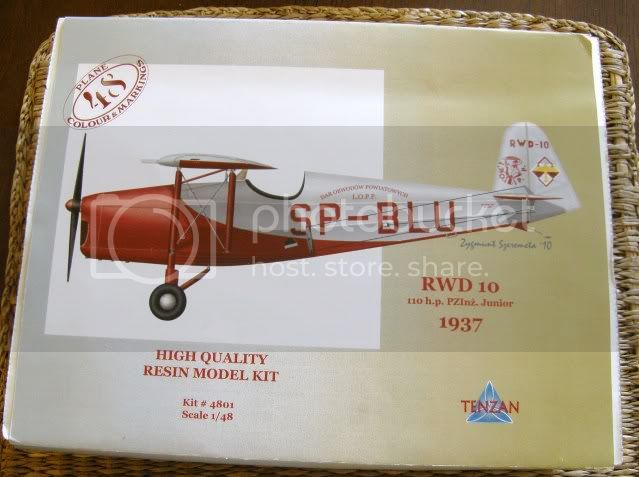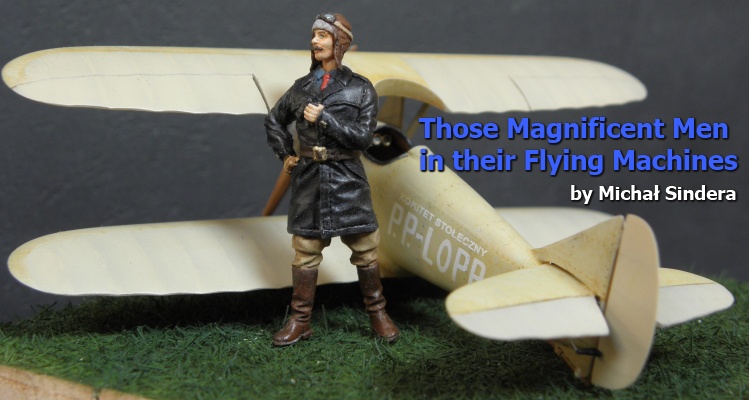1⁄48D-1 Cykacz
13
Comments
a bit of history
D-1 „Cykacz” was the first, still experimental, airplane designed and built in Poland after the Great War. Newly formed country, destroyed by the World War I and later the Polish-Bolshevic war in 1920 has been struggling in almost every possible aspect of its existence. In the autumn of 1924 then still a student of the Aviation Section at the Polytechnic of Warszaw, Jerzy Dąbrowski, designs and builds his first airplane. It was ready few months later. D-1 was powered by the just 16hp Blackburn Tomtit engine. It first flew on 25th February 1925 with Zbigniew Babiński at the controls. The engine sound was very characteristic and the plane was named „Cykacz”, I think it can be translated as „Ticker” in English.The airplane was very small. Its wingspan was just 5m, length 3,7m. Cockpit was so small that the pilot could get inside just up to his waist, flying with his upper halve outside the cockpit. Engine throttle lever had to be moved outside as the pilot could not operate it in a typical manner. You can see the lever protruding from the fuselage port side. The airplane flew about 40 times, until 1926. In the early 1930's it still could be seen standing in the hangar corner. Jerzy Dąbrowski continued his career. One of his later achievements, probably the most successful and most recognizable, was the bomber PZL.39 Łoś (eng. „Moose”).
about the model
As far as I know there is just one option to choose from in any scale. The kit was released as a resin casting by a small company „Tenzan” from Kraków in short series. It is a 1:48 scale kit. It consists of just about 20 parts, however you won't need more to build a complete kit. The castings were quite good. I just needed to do some slight cleaning from the casting blocks. There's not much to improve in the kit. I have added some symbolical plumbing and control cables in the cockpit. Two things which for sure are worth a bit more time are adding these few rivets on the fuselage and improving the engine cowling. Real plane had a characteristic ventilation gap between the spinner and engine cowling. To create it I had to sand down the cowling, thinning its edge and adjust the propeller shaft length as it will be the only point holding the propeller in its place.Having the major parts in place the kit was primed using a car part primer straight from the can and polished here and there. Real plane was covered with linen and plywood. After some typical preshading I painted the Gunze Radome for the linen and masked it. The same paint was used as the base for plywood, but the colour was highly lightened. Some fuselage panels were painted in a bit different shade. The structure of wood was made using a tiny piece of sponge and artistic oils applied „freehand”. The only thing I payed attention to was the keep the direction of „wood” on the particular panel. Other details were painted and finished using a common techniques, there's nothing worth mentioning.
Pilot figure is also a resin casting. This one was released by another Polish company – Toro. It's a one-piece kit, you just need to clean it from the typical remains of castings and paint in the way you like. Mine was painted with Lifecolour and Vallejo acrylics in just few hours. Standing next to the airplane gives a good imagination of the plane size.
Many thanks for visiting my feature. I hope you enjoyed. I am awaiting your comments and opinions on the forum.
Comments
Many thanks people for your comments. This was a very relaxing build without too much stretching out so I'm very pleased you like it. I have one more kit from the same company, although a bit bigger - the RWD-10, Polish aerobatic airplane. Maybe it will be one of my next projects and hopefully another feature.
Here's a sample boxart found in the internet.


APR 18, 2015 - 02:34 AM
Such a cute little aircraft, it would probably make a Pitts look big !
Nice!
Magnus
APR 19, 2015 - 07:02 PM
Hi Magnus,
thanks for your comment. How are your Spits and Tanks going? Any chances for update soon?
APR 20, 2015 - 12:57 PM
Amazing little thing. It appears to be in the wrong scale compared to the figure
APR 20, 2015 - 01:00 PM
Thanks! I think I forgot to mention that the pilot name is Lemuel Gulliver...
APR 20, 2015 - 02:01 PM
Really interesting build and a very nice history lesson. I had no idea planes were made that small. Looks bizarre next to the figure.
APR 21, 2015 - 05:50 AM
Yap, could be really small. Here are few pictures found in the internet.
Here's the designer himself in front of his plane.
 LINK
LINK
 LINK
LINK
 LINK
LINK
 LINK
LINK
 LINK
LINK
 LINK
LINKAPR 21, 2015 - 02:18 PM
Excellent build and presentation Michal.
I still cant believe how small this aircraft is, I'm surprised it had the power to take off with a pilot in it.
Andy
APR 21, 2015 - 04:33 PM
Hi Andy,
many thanks for a comment.
The engine was supposed to have the 25hp but after trials it occurred to be no more than 16hp. My lawn mover seems to be stronger. Needless to say it was the British engine...
APR 21, 2015 - 06:25 PM
It didn't, well not the first time.
On 25th Feb 1925, after some delays caused by engine problems, Lt Zbigniew Barbiński taxied all over Mokotów airfield but could not leave the ground. The problem was that there was not enough power to overcome a very sharp tailskid that cut deeply into the ground. The tailskid was changed and the next day Barbiński managed to get airborne after a long take off run. Further flights followed but their duration had to be drastically curtailed because of the very temperamental power plant.
The Blackburne engine (with and 'e' and nothing to do with the aircraft manufacturer) was supposed to produce 16 hp (not 26) but failed to develop more than 12 hp and rapidly lost power after a few minutes running.
LINK
LINK
Much better results were obtained after modifications to the engine including lowering the compression ratio, but the small diameter propeller designed by Jerzy Drzecykacz for higher speed proved unsuitable.
APR 22, 2015 - 03:42 AM
Copyright ©2021 by Michal Sindera. Images also by copyright holder unless otherwise noted. The views and opinions expressed herein are solely the views and opinions of the authors and/or contributors to this Web site and do not necessarily represent the views and/or opinions of AeroScale, KitMaker Network, or Silver Star Enterrpises. Images also by copyright holder unless otherwise noted. Opinions expressed are those of the author(s) and not necessarily those of AeroScale. All rights reserved. Originally published on: 2015-04-18 10:57:51. Unique Reads: 8726




























